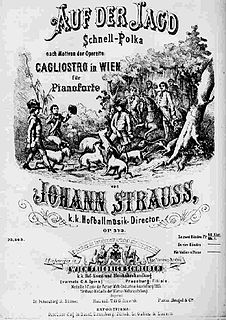
Operetta is a genre of light opera, light in terms both of music and subject matter.
Cagliostro-Walzer op.370 is a waltz by Johann Strauss II composed in 1875 based on themes from his operetta, Cagliostro in Wien which premiered on 27 February 1875 at the famous Theater an der Wien.
Vom Donaustrande is a polka by Johann Strauss II written in 1873. Its themes are drawn from his successful operetta, Der Karneval in Rom which premiered in Vienna's Theater an der Wien on 1 March 1873.
Schatz-Walzer op. 418 is a Viennese Waltz by Johann Strauss II composed in 1885. The melodies from this waltz were drawn from Strauss' operetta Der Zigeunerbaron which premiered to critical acclaim on 24 October 1885.
Trau, schau, wem!, Op. 463, is a waltz composed by Johann Strauss II. The composition was dedicated to the portrait painter Franz von Lenbach. It was based on melodies from Strauss's operetta Waldmeister – the work is therefore also known as "Waldmeister Walzer". It premiered on 15 December 1895 in the Golden Hall of the Vienna Musikverein, conducted by Eduard Strauss.
Du und Du, opus 367, is a waltz by Johann Strauss II composed in 1874. It derives from themes from his Die Fledermaus, the famous operetta, and its title and opening melody specifically from the Du-i-Du chorus of Brüderlein, Brüderlein und Schwesterlein in Act II.
Donauweibchen, Op. 427, is a waltz composed by Johann Strauss II in December 1887. The composition features melodies from Strauss' operetta Simplicius. It was first performed in January 1888 at one of Eduard Strauss's Sunday concerts in the Musikverein.
O schöner Mai!, Op. 375, is a waltz composed by Johann Strauss II. It features melodies from Strauss's fifth operetta, Prinz Methusalem. The waltz was first performed in January 1877, with Eduard Strauss conducting. The principal waltz theme of this work is a quote from the Act 3 duet for Pulcinella and Methusalem, while the remaining melodies are taken from Acts 1 and 2, including the Act 1 Chorus and Ensemble, "O schöner Mai!".
Banditen-Galopp is a galop composed by Johann Strauss II. It was arranged from melodies in Strauss' operetta Prinz Methusalem. The title of the composition is derived from the appearance in the stage work of a bandit gang intent on overthrowing the prince, and its main melody is in the Act 3 duet with chorus: "In der stille ganz verstohl'n werden wir Schätze hol'n." The finale of Act 1 provides the source of the galop's other tunes. The Banditen-Galopp was first performed in 1877.
Neue Pizzicato Polka, Op. 449, is a polka composed by Johann Strauss II. It was written in 1892 for concerts to be given under Eduard Strauss in Hamburg. Strauss later inserted the work as a ballet between the second and third acts of his operetta Fürstin Ninetta.
Bitte schön!, opus 372, is a polka composed by Johann Strauss II. The first two themes of the composition incorporate Strauss' operetta Cagliostro in Wien. The composition was first performed in the summer of 1872.

"Auf der Jagd", op. 373, is a polka composed by Johann Strauss II. The composition is based on melodies in Strauss' operetta Cagliostro in Wien.

Der Karneval in Rom —also known as Karneval in Rom— is an operetta in three acts composed by Johann Strauss II to a libretto by Josef Braun, Richard Genée and Maximilian Steiner. It was Strauss' second operetta and based on Victorien Sardou's 1861 comedy Piccolino. The work premiered on 1 March 1873 at the Theater an der Wien.

Prinz Methusalem is an operetta written by Johann Strauss II to a libretto by Karl Treumann, after Victor Wilder and Alfred Delacourt. It was first performed on January 3, 1877 in Vienna at the Carltheater. It achieved a run of eighty performances. The pot-pourri overture incorporates themes from the operetta, as well as other material that might have sometime been part of the planned score.

Blindekuh is an operetta written by Johann Strauss II on a libretto by Rudolf Kneisel. It was first performed in Vienna at the Theater an der Wien on 18 December 1878, its composition delayed by the death of Strauss' wife, Jetty Treffz. The overture was performed earlier at a charity event. The first run lasted sixteen performances, followed by performances in Hungary. The overture established itself in the repertoire of many orchestras and is often performed nowadays. A concert performance in 2019 of the opera with the Sofia Philharmonic and Chorus with soloists and conducted by Dario Salvi proved a success.

Waldmeister (Woodruff) is an operetta written by Johann Strauss II. It was first performed on 4 December 1895 at the Theater an der Wien. Although not as popular as some of Strauss' other operettas, such as Der Zigeunerbaron and Die Fledermaus, it was given eighty-eight performances, and was much admired by Johannes Brahms, a friend of the composer.
Indigo-Marsch, opus 349, is a march composed by Johann Strauss II. Its melodies are incorporated from Strauss' first operetta, Indigo und die vierzig Räuber. The work was first performed on 9 April 1871 at a concert in the Musikverein in Vienna, with Eduard Strauss conducting.
Carnevalsbilder, opus 357, is a waltz composed by Johann Strauss II. The waltz is based on melodies from Strauss' operetta Der Karneval in Rom. Strauss conducted its first performance in Vienna on July 9 1873. Oscar Straus later arranged the second waltz theme of Carnevalsbilder for his operetta Drei Walzer as the soprano aria Ich liebe das Leben.

Der lustige Krieg is a three-act operetta composed by Johann Strauss II. The work was first performed on 25 November 1881 at the Theater an der Wien. Its libretto was by F Zell and Richard Genée. The operetta was well received at its premiere, and was performed 69 times during its first run.



